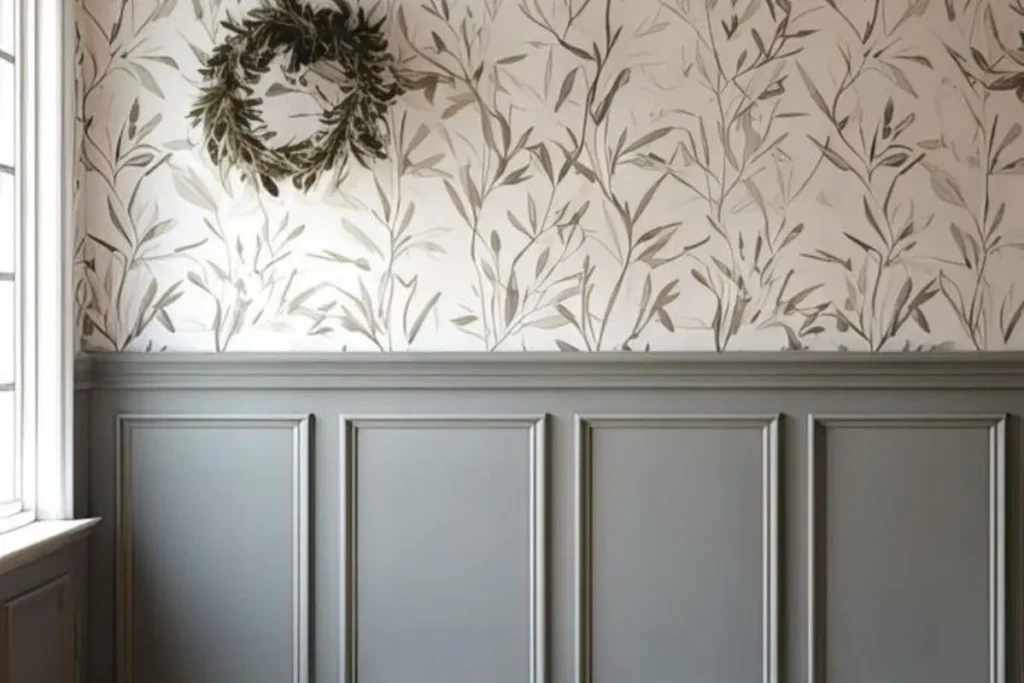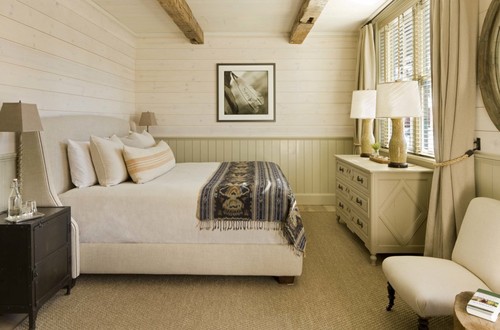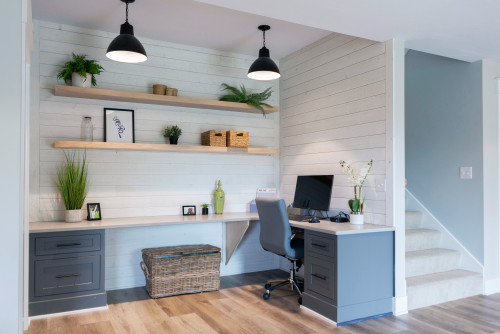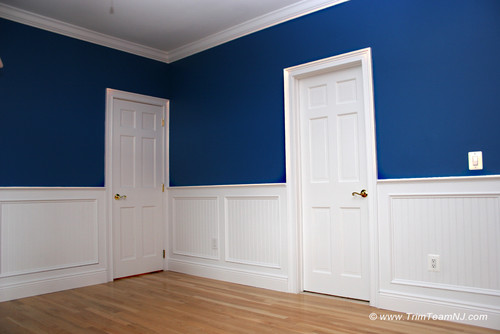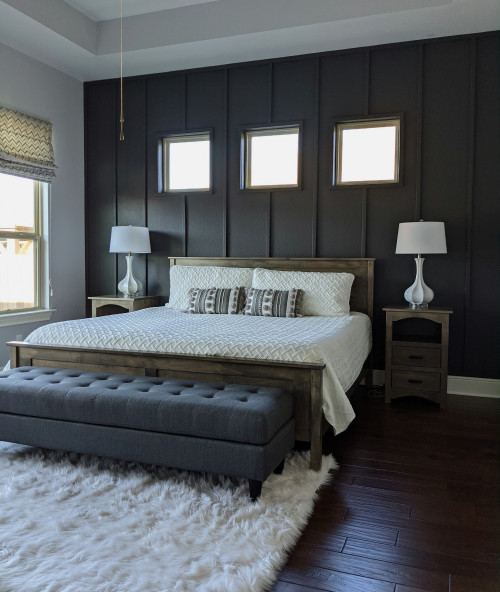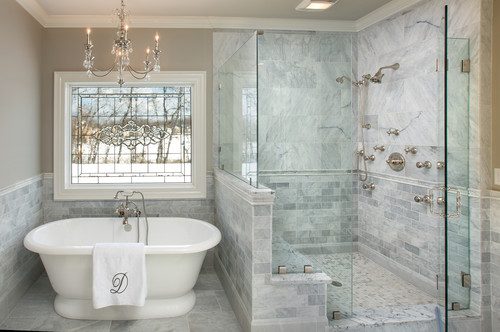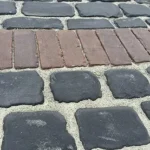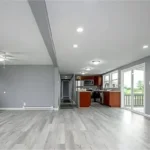When it comes to adding style, character, and architectural interest to your interiors, few upgrades are as effective and affordable as half wall paneling. Also known as wainscoting, half wall paneling adds texture and warmth, defines spaces, and protects your walls—all while elevating the overall look of your home.
Whether your space leans modern, traditional, or rustic, there’s a paneling style to match. These half wall paneling ideas are more than just decorative—they’re practical, impactful, and surprisingly versatile.
10 Half Wall Paneling Ideas For Any Room
1. Classic Beadboard Paneling
Beadboard features vertical planks with distinctive “beads” or grooves between each panel, offering a charming, timeless appeal.
Pros:
Adds a cozy cottage or farmhouse feel; the vertical lines can make ceilings look higher and spaces feel taller. It’s easy to paint and works well with almost any color palette.
Cons:
May feel dated in ultra-modern spaces; can be tricky to clean between grooves if not sealed properly.
Best for:
Kitchens, bathrooms, mudrooms—especially where you want a clean, bright, and airy look with vintage charm.
2. Modern Shiplap Paneling
Shiplap is a stylish favorite in today’s design trends. With wide, horizontal boards, it lends a clean-lined yet relaxed feel.
Pros:
Creates a visually wider space thanks to horizontal orientation; easy to install as a DIY project; pairs beautifully with neutral or bold colors.
Cons:
Overuse in a home can feel too trendy or repetitive; dust can accumulate between boards if not sealed tightly.
Best for:
Living rooms, hallways, or bedrooms that need texture without overwhelming the space.
3. Raised Panel Wainscoting
This more traditional option features framed and elevated panels for a rich, dimensional finish that screams luxury.
Pros:
Elevates any room with refined, classic style; provides excellent wall protection; adds value to traditional or historic homes.
Cons:
Requires precision and skill to install; usually more expensive due to detailed craftsmanship.
Best for:
Formal dining rooms, libraries, entryways, or offices where sophistication and structure are essential.
4. Board and Batten
Board and batten consists of wide boards with vertical battens covering the seams, creating a bold and structured grid-like effect.
Pros:
Offers depth, texture, and a bold architectural statement; can be customized in spacing and layout for different styles.
Cons:
May feel too heavy or rustic in very sleek, modern spaces; more materials are needed, raising the cost slightly.
Best for:
Bedrooms, staircases, or any area needing a balance of rustic charm and visual weight.
5. Slatted Wood Panels
This contemporary option uses narrow vertical or horizontal wooden slats spaced apart, often with a backing to create depth and rhythm.
Pros:
Adds acoustic benefits by absorbing sound; creates a high-end, minimalist look with lots of texture; visually elongates walls.
Cons:
Requires frequent dusting; difficult to clean between slats in high-traffic or messy areas.
Best for:
Modern entryways, behind beds as statement headboards, or home offices needing sound absorption and style.

6. Painted MDF Panels
MDF (Medium-Density Fiberboard) panels are smooth, uniform, and budget-friendly. They can be painted any color to match your décor.
Pros:
Extremely cost-effective; versatile with color and layout; easy to install and modify if trends change.
Cons:
Susceptible to water damage; less durable than real wood over time; not suitable for humid areas.
Best for:
Kids’ bedrooms, rental homes, or accent walls where you want maximum visual impact for minimal cost.

7. Half-Tiled Wall with Cap
Combining tile on the lower half of the wall with a cap or trim creates a sophisticated blend of form and function.
Pros:
Water-resistant and durable; the combination of textures adds dimension; ideal for areas with frequent cleaning.
Cons:
More time-consuming to install; tile choices and grout maintenance can add upkeep.
Best for:
Bathrooms, laundry rooms, or kitchen backsplashes where durability is as important as design.
8. Diagonal or Geometric Designs
Want to break the mold? Lay out your panels in chevrons, herringbone, or geometric grids to create a bold, architectural statement.
Pros:
Unique and eye-catching; instantly modernizes a room; creates a custom designer look.
Cons:
Advanced layout and cutting required; not ideal for beginner DIYers or small budgets.
Best for:
Accent walls, powder rooms, or creative spaces like art studios or home offices where you want to showcase personality.

9. Natural Wood Tone Paneling
Sometimes the best design choice is to let natural materials shine. Use stained wood panels to create a cozy, organic vibe.
Pros:
Brings natural warmth and texture; works well with both modern and rustic styles; adds rich character to a room.
Cons:
Requires sealing and maintenance to prevent warping or fading; can darken small or poorly lit spaces.
Best for:
Scandinavian, Japandi, or boho interiors; bedrooms or reading nooks where comfort and texture matter most.
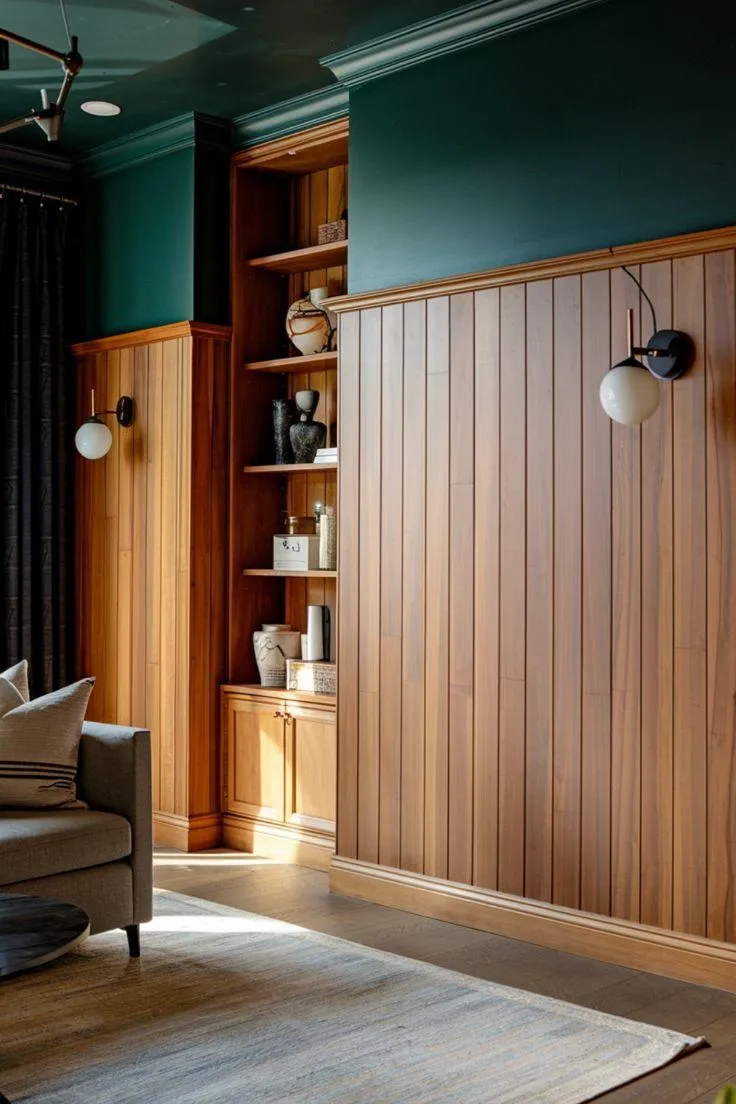
10. Two-Tone Paneling
A two-tone approach uses a different paint color on the paneling than the upper wall, creating striking contrast and added depth.
Pros:
Adds visual interest without the need for additional materials; makes ceilings look taller or spaces feel more layered.
Cons:
Requires a good eye for color combinations; improper color pairing can feel disjointed or clashing.
Best for:
Staircases, long hallways, or rooms with high ceilings where vertical contrast enhances proportion.

Tips for Choosing the Right Half Wall Paneling
- Style Consistency: Match paneling style to the architecture of your home. For example, colonial homes pair well with raised panels, while modern homes lean toward slatted designs.
- Material Matters: Use moisture-resistant materials like tile or sealed wood in bathrooms or kitchens.
- Color Strategy: Darker lower walls create grounded contrast; lighter tones lift the space visually.
- Scale and Height: Typically, paneling is installed one-third to half the height of a wall—adjust depending on ceiling height and furniture placement.
Conclusion
From clean and classic beadboard to bold geometric slats, these half wall paneling ideas can totally change how a room feels—adding charm, structure, and a designer look. Whether you want rustic simplicity or luxurious detail, there’s a style here to match your goals and budget.
With smart material choices and a bit of creativity, half wall paneling can become the focal point that ties your entire room together.
Discover more design inspiration, renovation tips, and DIY how-to guides at ecobuildhome.com. Whether you’re updating a single room or reimagining your whole home, our expert-backed articles help you create beautiful, functional spaces without the overwhelm.
